The beginner and the protection dog
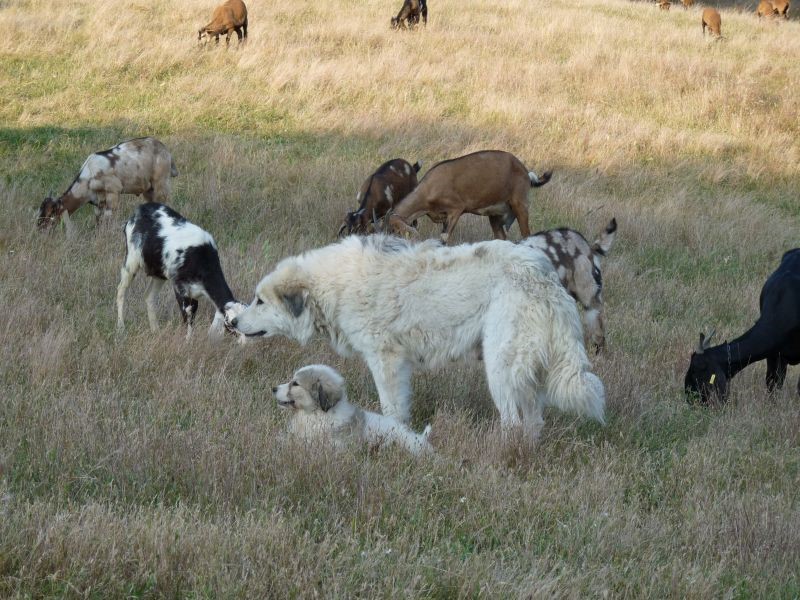
SUMMARY
1 – THE INTRODUCTION OF PROTECTION DOGS: A REAL CHALLENGE FOR BREEDERS
2 – THE PROTECTION DOG, BETWEEN DREAM AND REALITY
3 – DIALOGUES WITH BEGINNERS IN PROTECTION DOGS
4 – WHO CAN ACCOMPANY THE BEGINNERS?
5 – PUPPY FOLLOW-UP: THE IMPORTANCE OF THE FIRST MONTH
1 – THE INTRODUCTION OF PROTECTION DOGS: A REAL CHALLENGE FOR BREEDERS
Introducing protection dogs into a herd proves to be a real challenge for breeders and shepherds. With the disappearance of large predators more than a century ago, all the knowledge about protection dogs in France was lost. The return of the wolf on the national territory and its rapid expansion take almost by surprise many sheep, goat, cattle and equine farmers. They do not imagine that a wolf can appear in the middle of their herd. The first attacks therefore provoke a real shock, especially since the French state continues to minimize the situation and conceal the facts.
Starting puppies for the protection of your herd when the wolf has been seen a few dozen kilometers from home, it is already four years late in setting up dogs. Four years is the minimum time necessary for the training of dogs and their discovery and control of the territory or territories in which their herd evolves. Nevertheless, the dog remains the only means of protection capable of adapting to the changing strategies of the wolf who is a remarkably intelligent predator.

DHARA Soum du Prat d’Ourey
There is still a lot of research and breeding work to be done for the protection of equines and cattle. My personal observations show that it would be quite possible to develop lines of protection dogs with a particular affinity for these two species.
The process is much more complicated than it seems at first glance. The use of protection dogs profoundly changes the organization of work, breeding and farming. The arrival of protection dogs is a real upheaval whose consequences are very heavy for breeders and shepherds. Consequences all the more important as breeders are not at all prepared. We can only regret the lack of anticipation of the French state in this area while the wolf has been present in France for 30 years already.
The presence of protection dogs leads to a real overload of work. Dogs are an inexhaustible source of hassle for their owners on a daily basis. There is a time of learning and discovery, both for dogs and for men, and it is long.
Shepherds need healthy, balanced and effective protection dogs at work. These characteristics can only result from real genetic selection, which is currently sorely lacking in France. It is complicated to find puppies from protection lines followed and selected over several generations. Dogs need shepherds who understand them which requires an unusual letting go and difficult to acquire especially as myths and erroneous legends continue to run the countryside.
For 30 years with my university curriculum as a teacher-researcher in zootechnics I have been conducting, on my own funds and without any subsidies, research on protection dogs, their use and breeding (1). I study the protection dog as Dr. Gordon Haber studied the wolf for 43 years by observation in its natural environment (2). The protection dog is therefore studied in his herd, nowhere else, and especially not in experimental devices that make no sense to him and that do not allow to grasp all the nuances.
I share on my website, with pleasure and graciously, the fruit of my work to those interested in this subject.
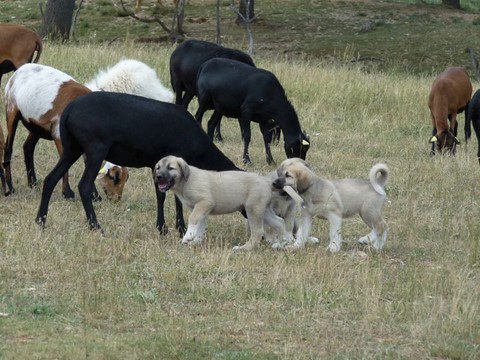
Puppies must develop in an environment of security and love that will allow them to express their full genetic potential later on
2 – THE PROTECTION DOG, BETWEEN DREAM AND REALITY
From my experience of more than 20 years now in puppy placement, I have found that beginners in protection dogs often have unrealistic expectations. Faced with the abilities of a puppy who will remain a simple baby until at least two years, if he is raised in a family pack, or three years if he has to learn the trade on the job, these expectations are disproportionate and out of reach of puppies. What's more, puppies raised without adult trainer dogs will probably never reach the skill level of puppies educated by adults. Indeed, they will not benefit from the transmission of the culture and knowledge of the pack. They will have to create a new pack culture from their own experiences and this will take many years.
Would a 4-year-old be asked to drive a combine harvester on a county road? Certainly not. Yet this is about the demand of beginners in protection dogs facing a small two-month-old puppy.
The vast majority of new protection dog users have driving dogs. In a fairly natural way they try to behave with protection dogs as they usually do with their driving dogs, especially by giving orders. Outside there is no more opposite in terms of behavior than driving dogs and protection dogs. If the driving dog is under the almost permanent control of the human, the protection dog requires an almost total letting go. It is an independent, intelligent, sensitive, and courageous dog making decisions on its own. And it is a far from simple exercise for the beginner in this area.
Beginners want to go way too fast. No sooner has the puppy arrived in the sheepfold than they begin to analyze all his reactions. However, puppies are adults in the making. They must be given time to mature. And it takes ... Years. And not weeks or months. Patience is the first key word. The second is letting go, which is usually very complicated for new users.
It takes a minimum of 20 years of selection to produce puppies whose morphology and temperament are highly predictable. The choice of the breeder and the quality of the follow-up he can offer are therefore decisive in the success of the project to integrate protection dogs into his herd.
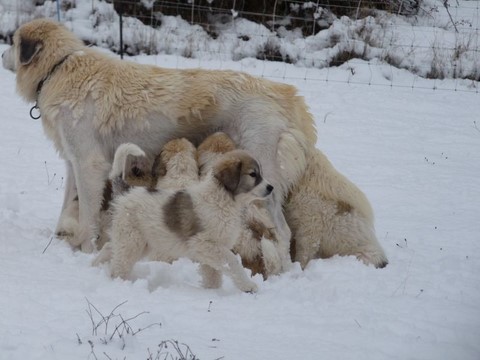
The goal of a breeding program is to produce puppies with highly predictable morphology and working ability. This is undeniably a long-term task.
The source of many problems encountered when setting up protection dogs comes from the fact that the fundamentals of the protection dog are completely ignored:
Nowadays we would like to ask protection dogs to work in conditions for which they have never been selected in a traditional way.
- Protection dogs have never worked alone, they work in packs with other protection dogs.
- Protection dogs have never been left alone in the herd without human presence; They work in partnership with their humans.
- Protection dogs learn their craft in their first three years by imitating the behavior of adults.
- Protection dogs simultaneously protect a herd and a territory. They know very well how to distribute themselves geographically over the area to be protected. Obviously there must be quite a few. Some remain in the herd and its immediate surroundings while others patrol the animals further away to mark the territory, detect danger and block approaching predators. In no case were these dogs selected to kill predators. Aggressiveness is not one of the qualities sought in a protection dog, but the dog must have a very good mind.
- Dogs have affectionate relationships with each other and with the animals they protect. They know and recognize each other. These relationships must be absolutely preserved and cannot be changed at every turn when changing batches or separating individuals from the pack.
Beginners often have totally unrealistic expectations compared to protection dogs. The expectations of a puppy intended for the conduct of the herd are much lower because the shepherd knows that he must be trained in the conduct of the dog which is less obvious in the case of the protection dog who is supposed to work alone.
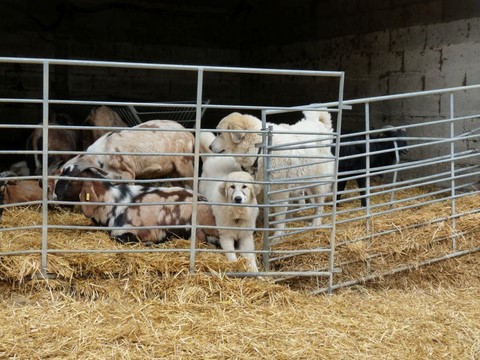
CAYA de la Vallée du Bois Doré and her daughter HILLI du Hogan des Vents.
There is no better teaching than the one transmitted by the adult dogs.
The protection dog
It's a Know how To Do & A Know how To Be
A very long learning process
As much for the human as for the dog
3 – DIALOGUES WITH BEGINNERS IN PROTECTION DOGS
Some examples of conversations...
DIALOGUE with a beginner N°1
Beginner:
"The person who will follow us thinks he is able to give us the means to educate dogs so that they can be manipulated by all. This was one of the conditions before we committed to protection dogs because in our system employees are often forced to change and dogs must be able to adapt to all new faces. »
My answer:
It is absolutely unrealistic and impossible to have protection dogs that can be handled by all ... It is absolutely not in the behavioral register of protection dogs to tolerate the intrusion of unknown people into their herd.
Many years ago I was away from my farm for a week to go to training in Switzerland. I entrusted my farm to a person who had been coming regularly to help me for two years and whom my dogs knew perfectly. After two days they prevented this person from entering the sheepfold. In my presence this had never been a problem.
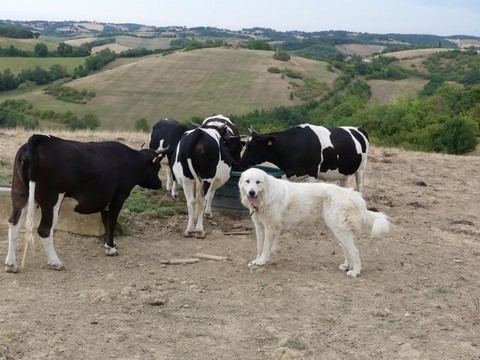
THOR du Hogan des Vents with its Bretonne Pie noir cows. The protection of cattle and horses implies that the puppies are raised specifically with these species from their birth.
DIALOGUE with a beginner N°2
Two small protection dogs, three months old and born to a dog from the Hogan des Vents, arrived 6 days ago and were introduced directly into a large batch of lambs. The first meeting was a bit hectic because the lambs were totally frightened by the puppies playing with each other and trying to get in touch with them. This behavior is classic.
It is always best to first place the puppies next to the herd so that the animals can get used to their presence. The genetics of protection puppies push them to go naturally to animals and that's what they always do.
This first contact is always frightening for the herd who likens them to predators. The situation will be all the more delicate as the herd will have previously had a bad experience of canids following attacks by domestic dogs or wolves. In these cases, the contact will have to be even more gradual. For example, it is possible for the breeder to walk a few days in the herd with the puppies in his arms in order to control this presence.
A common mistake is to imagine that it is easier to manage females than males. The use of two females quickly reaches its limits when they reach puberty and trigger their first heat. At that time they are no longer available to the herd and can attract males, both dogs and wolves. It is then useful to introduce a male in the second year in order to balance the pack and increase the level of protection. A male protects his herd but also his and puppies.
Even if they are protection dogs that spend their lives with their herd, it is essential to have reinforced kennels in order to insulate in heat. Just like males, they are capable, under the effect of hormones, of quite unexpected feats and an aggressiveness between them that can surprise. I often say that they should be locked in a safe twice.
On a first video I discover the shelter that has been prepared to accommodate the in a batch of lambs. It is completely enclosed like a small hut. This is not suitable because it completely isolates the puppies from the herd and vice versa. It is necessary that visual contact and olfactory contact between puppies and the herd can easily be established. Attention protection puppies are the kings of escape! And they leave very quickly to discover their environment if they are introduced at the age of three months. They must be able to evolve in a secure area, especially if roads are close to the farm.
Beginner:
Hello tomorrow I will take out a batch of animals half a day can I walk a little with the so that they take their bearings without leaving them alone?
My answer:
Yes of course, keep them on a leash to start .... Take them around the park explaining that this is the limit they must not exceed (talk to them as you would with a human, they will understand). If you feel that they can come back to you by calling them, you can also leave them free for a little while. If you can make a video that I see their behavior and interactions with the sheep.
Beginner:
OK but does it have to be with the lot they are currently in or can it be another batch?
Should I take both or one at a time?
My answer:
It would be better with the lot they know and it would be nice to take both together yes. If they are other beasts it will make too many novelties for them.
Beginner:
Ok his walk thank you, I'm filming this tomorrow. From when I can put them in other batches, because there they are with lambs it goes great. No one is afraid anymore. Knowing that I have a lot just struggled, a lot that lambs in 15 days and a lot with small lambs.
My answer:
Avoid changing too much so at least 3 weeks in a batch before the change. The week before changing make them go on a leash in the new batch like 10 minutes a day that they begin to take landmarks just like the new ewes. Do not put them permanently with ewes + lambs but make them make small visits in these lots like 5 minutes on a leash and 5 minutes in freedom under supervision of course. Before the grazing season it would be necessary that all your animals have come into contact with the two little dogs.
If the first months, the beginner may have the impression of mastering the puppies, reality can quickly catch up with him when they reach the age of puberty around 8-12 months. The size of dogs is already imposing even if their growth will not end until around 4-5 years. Despite this large size they are still babies in their heads. They need guidance, especially puppies educated without adult dogs for which the shepherd is both a parent and a teacher.
These young tend to overreact to unusual events such as the arrival of strangers approaching their herd. They bark a lot at any unknown event, especially in their first year of life. This is the case, for example, when they discover the natural sounds of the four seasons such as the cuckoo song in spring.

The setting up of a pair of puppies greatly facilitates their integration into a new herd. The puppies reassure each other, play a lot together, and face the unknown with more confidence.
DIALOGUE with a beginner N°3
Tahir and Oltan du Hogan des Vents, two brothers, were placed in the herd together at the age of three months. They are now one year old.
Beginner:
While Oltan remains well among the sheep, Tahir reacts very demonstratively as soon as a stranger approaches the sheepfold: he puts both his legs on the barrier and barks very impressively. I dare not bring people in for fear that he will attack them. I have a very good relationship with my two dogs. I have no problem with them.
I want them to behave like your dogs. When I came to your house with my wife, my young children were also with us in the pasture. All your dogs were calm around us, the children, my wife and I never felt threatened.
My answer:
Your dogs are still very young and learning. They cannot have the discernment and control of adult dogs. My pack is over 20 years old, it is stable with a balanced age pyramid. There are young dogs and old dogs. Young people adopt the behaviour of elders. When I bring strangers into the herd, the elders know that there is no danger and behave normally without triggering a warning in front of strangers. Young dogs imitate them and remain calm. Note that my dogs are well educated, they do not jump on people either.
A few years ago I hosted a visitor. As she was particularly unpleasant I asked her very directly to leave my farm immediately. At that moment all my dogs, who noted my anger, totally changed their behavior. They walked this person back to the gate, all grouped behind him and growling. Once she passed through the gate everyone became calm again and they returned to their herd.
In your case, these young dogs follow what their protective genetics dictate. Nevertheless, they do not yet know how to dose their reaction. When in doubt they give everything they can. They are already perfectly distributed in their role with a dog in the herd and a dog on the outside. It is therefore the responsibility of the dog on the outside to block any intrusion. That's what Tahir does.
Now it is very important not to let it become anchored and reinforced in this behavior. You must teach him discernment by bringing unknown people with you into the flock. You must teach him that if people are with you, they are not a danger to his sheep. It is obviously necessary to enter the herd calmly and give the dogs time to sniff the newcomers in order to identify them as non-dangers. This is where your role as a teacher comes into its own sense and importance.
In this process of integrating protection dogs, it is absolutely necessary to be accompanied by an expert in the subject. Indeed, beginners often misinterpret the behavior of dogs.
DIALOGUE with a beginner N°4
Pastis and Poupette du Hogan des Vents, brother and sister, joined their herd of goats at the age of three months.
Beginner:
First day at the arrival of the puppies: They are super wise. They sleep quietly, their heads on my foot... They just raise their heads from time to time to ask for a caress ... Goat poops look good... There they both sleep. I'll show you the pictures. I believe they are already at home... Goats are curious neither frightened nor aggressive... I'm too proud of my kisses. Not disturbed at all. I am totally reassured for the future.
Message 10 days after the arrival of the puppies: Otherwise, a great thing just now. I went to close the kid window because of the wind. They were all scared suddenly. And then I see my Poupette arrive at the bottom, followed by Pastis, who starts barking at me until she recognizes me! I was super proud.
Inevitably there are highs, but also lows. On the same dog:
Message two months later: Poupette ran away again. I don't think she must be happy with us. She is unmanageable and does not listen to anything. She harasses the most fragile goats to lick them when they don't want to. Runs after the goats. But above all does not stop neither when we ask him, nor when we grumble ... And bar as soon as she can.
On this farm the puppies have been placed in totally unsuitable living conditions that do not allow them to flourish (And bar as soon as she can). And it is obvious that the bond with this dog is not enough for her to respond to the requests made to her (do not stop neither when asked or growled). This link was not set up correctly given the reaction of the young dog.
At a certain stage, and despite several warnings, dialogue with the expert is no longer possible when the beginner refuses to follow the proposed advice. He must then fully assume his responsibility in the defeat of the dogs. The human being what he is, questioning is always difficult, and it is usually the dog and its breeder who are accused of all evils. So goes the world.
Since 2021, in collaboration with the training platform AGRILEARN I have set up a course on protection dogs specifically for beginners in the field. This training includes a 4-hour online course whose videos were shot on my farm with my dogs, and 4 hours of videoconferences with me to address the particular situations of the participants. For farmers contributing to VIVEA, training is 100% covered.
4 – WHO CAN ACCOMPANY THE BEGINNERS
Unless you have at least 10 years of experience on protection dogs, in their use and in their breeding, it seems wiser to avoid giving advice to beginners. The human needs a lot of time to grasp all the nuances of these wonderful dogs. The one who accompanies must be very available. This is important for beginners who need to be supervised and reassured.
Seeing beginners in protection dogs, themselves often in difficulty with their own dogs, start giving advice at all costs does not seem beneficial to anyone. The protection dog requires real skill. To understand it, you have to know all the subtleties of these very particular dogs, different from all other breeds of dogs. You have to become a protection dog yourself.
On farms that encounter difficulties of all kinds, the protection dog, the last to arrive on the farm, is also often used as a scapegoat for all other problems. And this does not facilitate its integration.
Knowing protection dogs means living with them 24 hours a day, giving them full latitude to express their natural behavior. That's what I've been doing for over 20 years. This is the only way to understand them perfectly. It also means giving birth to puppies and accompanying their evolution, placing them in new herds, and ensuring their follow-up. There is no better training of trainers.
My dogs never receive orders for work. The famous order to return to the herd makes no sense for a protection dog ... Should he be told to go to the wolf when the predator approaches the herd? Of course not. He knows, if he has been well selected, how to behave in any situation.

BOUGNETTE du Hogan des Vents and her son ISIS du Hogan des Vents. To create a working line requires at least 20 years of breeding in order to select hardiness and aptitude for protection work. To obtain a good female for reproduction, it is necessary to raise four of them.
Poor preparation and insufficient training are the source of great stress for new users. Having a mentor is a guarantee of security and success.
It is essential that protection dog beginners be able to communicate with a resource person as often as necessary. You should never wait... with the hope that things will improve. This is never the case. It is necessary to intervene quickly as soon as a question arises, whether in terms of behaviour or health.
Sending videos to your mentor is a very good way to detect early errors that are taking place. It would be helpful to show him the facilities provided for the puppies before they arrive, and to make videos every day for at least the first week. Depending on the behavior of the puppies, occasional videos can also be made to discuss particular situations that question the shepherd.
For a better understanding of protection dogs
A young protection dog is considered to be an apprentice during its first two years in the herd. Until he was two years old I talk about "puppy" and not dog.
Thus the minimum training period of a puppy is 2 years in good conditions, that is to say under the supervision of experienced adult dogs whose role is to educate and protect them.
Without experienced adults to guide and protect them, this training time is inevitably longer, and closer to 3 years, as puppies have to learn on the job and do their own experiments. And they will probably never reach the skill level of puppies trained by adult dogs because they will not benefit from the transmission of culture and knowledge of the pack. They will have to create a new pack culture from their own experiences.
This is why I advise introducing a new puppy into the pack as soon as one of its members reaches the age of 5 years. The puppy will be able to receive instruction from the elders while making his own experiences.
It is important to remember that attachment to the herd is a genetic trait and that there is no need to create it, if you have of course the right genetics which is a prerequisite for a protection dog. This particularity that defines protection dogs has been selected for centuries by shepherds all over the world, along with non-aggressiveness towards humans.
When there is only one dog in protection he is constantly torn between staying in the herd and patrolling around the herd to prevent danger and mark the territory so that other canids know that said territory is already occupied. Two or more dogs know perfectly well how to divide these roles. Only one dog is in an unbearable position which is for me abuse. This dog is exhausted both physically and mentally. He wears out and his career will be all the more reduced. The dog just like the wolf, its ancestor, is undeniably a pack animal, it is not made to live alone of its species.
Respect, connivance, and collaboration are the keys to successful cooperation between dogs and humans. Protection dogs are not tools, they are the companions of shepherds. It takes time for breeders and shepherds to get acquainted with the work of protection dogs and time for dogs to gain experience. Over time, the effectiveness of the entity "shepherd – flock – protection dogs – driving dogs" improves.
Whenever a dog under two years old makes a mistake it is you who are the first responsible for having put him in a situation to do the stupid. You have to be able to take responsibility for your mistakes and not blame all the blame on the puppy.
It is clear that the introduction of protection dogs requires the shepherd an essential investment of time because he will be the teacher of the puppies and their surrogate parent. Without availability to train puppies it is better not to take them. Even if it means having the inevitable disadvantages of protection dogs, it is also better to be able to enjoy their advantages. A poorly educated dog is a lot of problems for little or no advantage.
Do not expect a puppy to behave like an adult dog. Just like driving dogs, protection dogs need to acquire a certain maturity. They are likely to make mistakes and that's normal. Too many dogs have been eliminated for youthful mistakes when they would probably have become excellent protectors.
It is up to the shepherd to teach his puppies the right behaviors and provide them with security throughout the learning period. When the puppies arrive, the priority is to create a bond of trust and love with them. Never reject a puppy that requires attention because it is actually a request for safety. It is therefore necessary to reassure him and not to scold him.
Saving a few hours on puppy training time is guaranteeing months or even years of problems with your dogs. It's not worth it. When it comes to protection dogs, you have to do everything right or do nothing.
5 – PUPPY FOLLOW-UP: THE IMPORTANCE OF THE FIRST MONTH
The cow-calf or pastoral technician will have to question the shepherd about the behavior of the puppy, especially during the first month of presence in the herd, which remains decisive for the success of the implementation. I have observed, in experience, that human errors occur very quickly and immediately impact puppies in their learning.
For this follow-up of the first month I propose to the breeders / shepherds to return me a simple questionnaire, quick to fill, retracing the behavior of the puppy at D + 7, D + 10 and D + 30 (D being the date of arrival in the new farm). This document can be found in my regularly updated education protocol (4).
This allows me to detect very quickly a drift in the behavior of puppies. Any nibbling towards humans or animals should be strictly forbidden to puppies. Puppies raised in good conditions respond very well to growling that stops them in an undesirable action, such as running behind a lamb. The use of growling by ladies requires some training because it is not very natural to them.
With this in mind, the important points to observe in the puppy are:
2 - Contact with the shepherd's family
3 - Contact with sheep/goats/cattle/horses, adults
4 - Contact with lambs/kids/calves/foals
5 - Contact with other protection dogs
6 - Contact with driving dogs
7 - Walking on a leash

For each assessment date, a result with 3 ratings "AVERAGE" and/or "INSUFFICIENT" should trigger a quick contact or visit to the farm in order to analyze the living conditions of the puppy and its reactions in the herd and towards people.
DIALOGUE with a beginner N°5
Tarkan and Taima of the Hogan of the Winds are brother and sister. They joined their new flock of sheep at the age of three months. In this herd they found Scandale a young Kangal dog of 18 months for whom the introduction to the herd was difficult insofar as the breeders had no experience with protection dogs. The integration of Scandale generated strong tensions between the dog and his human because the dog played with the animals and did stupid things. On the farm there are also driving dogs but they are older and do not play too much. The puppies immediately established a very good relationship with the young Kangal who represents for them safety and also play. She occupies the place of the mother from whom they were separated.
Here is the evaluation of the first month made by the breeders on the grid that accompanies my education protocol.
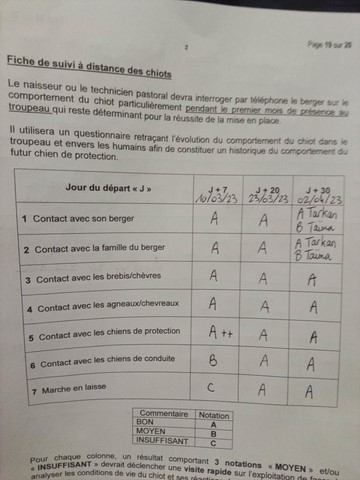
Beginner:
Hello, everything is fine for the puppies, at D + 30 we put B in Taïma because she became a little fearful again.
On the other hand, as it has been nice and hot lately, we put everyone outside, at the barn there were only 3 rams and some lambs to fatten, it was all empty, but we did not dare to put the dogs outside. Which is best? Soon there will be no one left at the barn.
My answer:
If it is possible to keep an eye on the puppies you have to put them outside with the herd yes. Can an event explain Taima's change in behavior?
Beginner:
The Shepherd yelled at Scandal harshly and Taima was probably afraid.
My answer:
That's it, without a doubt. What had Scandale done? You have chosen its name LOL
Beginner:
The problem is that the building we rent, we do not rent it in its entirety. The owner stores equipment there and Scandale goes to snoop in his belongings and destroy things (gloves, screws, cans, etc.). As I say to the Shepherd, it is up to us not to give him the opportunity to do, but there as we are not at home it is complicated. And the Shepherd took it in the act so he wanted to mark the occasion.
My answer:
As I often say, when a dog under 2 years old does stupid things it is 100% the fault of the master who put him in a situation to do the stupidity. You are absolutely right, it is up to you to take the necessary precautions so that the dog does not pass in the part of the barn that you have not rented. In this case there is collateral damage on the puppies which is a shame and may compromise your relationship with them. You really have to be careful. They are sensitive dogs.
IN CONCLUSION
Educating puppies for the protection of herds is ultimately not so complicated but requires an unavoidable investment of time for a minimum period of two years. It is essential that puppies spend their first three months of life at their birthplace in contact with adult protection dogs. Learning after three months will be all the faster if the puppies have been in constant contact with experienced adults, in an environment rich in stimulation, and surrounded by the affection of their breeder.

Plus important que la race du chien de protection est son naisseur.
The first two years are trying for beginners who navigate between absolute wonder and total despair depending on the behavior of their puppies. It is important to be supervised by a true expert on the subject able to analyze, reassure, propose and encourage. Accompanying beginners requires a great deal of experience both in breeding and in the use of protection dogs.
Protection dogs perform feats every day by protecting their herds with discernment, sometimes risking their lives. Observing them is for me a source of permanent wonder. And also a teaching that I try to transmit so that protection dogs and breeders / shepherds live in complicity and harmony for the greater good of their herds.
Notes
(1) Mathieu Mauriès. Selection of the Mountain Dog of the Pyrenees – The work of the Hogan des Vents (2022)
(2) Gordon Haber & Marybeth Holleman. Among wolves: Gordon Haber's insights into Alaska's most misunderstood animal (284 pages). University of Alaska Press (2013)
(3) Mathieu Mauriès. Selection program of the Pyrenees Mountain for the breeding of the Hogan des Vents (2019)
(4) Mathieu Mauriès. First integration of protection dogs into a herd – Protocol for setting up two protection puppies – 2023 beginner's guide – Method Hogan des Vents (2023)
All my articles are available on my hogandesvents.nutritionverte.com website, under MY PUBLICATIONS on the home page.
This text may only be reproduced in its entirety and mentioning its author, Mathieu Mauriès, and his website